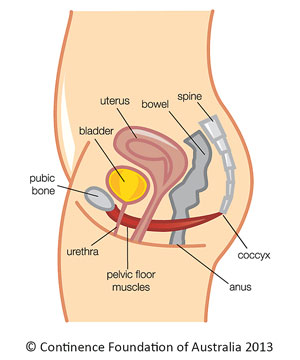Reply To:
Name - Reply Comment

 Have you noticed that a small amount of urine leaks out accidentally when you cough, sneeze or lift things during pregnancy? You could be having a condition known as pelvic floor dysfunction.
Have you noticed that a small amount of urine leaks out accidentally when you cough, sneeze or lift things during pregnancy? You could be having a condition known as pelvic floor dysfunction.
Q What is the pelvic floor?
It is a sheet of muscles and ligaments extending from the pubic bone in the front of our body to the base of the spine situated in our back. Basically it is a balloon-like membrane which can stretch to a certain extent, according to the weight it bears and come back to its original position once the weight is removed.
QWhat is the role the pelvic floor plays?
It bears the weights of the bladder, bowel, uterus, the womb and controls the emptying of the bowel and bladder.
When these organs are not well supported, the sphincters cannot be squeezed properly and it causes a stress incontinence which leads to the leakage of urine and a dragging feeling when you cough and sneeze. It can also lead to the sagging of the uterus and other organs. Moreover, it affects the vaginal muscles. If your pelvic floor is overly stretched, there is a reduced satisfaction in sexual activities and less sensitivity in the vaginal area.

QWhat is pelvic floor dysfunction during pregnancy?
When you are pregnant your body has extra weight to bear. This causes a lot of stress on the pelvic floor, causing it to become more stretched than usual. As a result, the floor can weaken from the 12th week of pregnancy. Constipation, which is a common complaint among pregnant mothers, can also lead to pelvic floor dysfunction.
QWhat can I do to maintain a strong pelvic floor?
Doing pelvic floor exercises on a regular basis can prevent this condition during pregnancy and even after. It helps increase the blood supply to the perineal area after the delivery, which will shorten the period of healing.

Always squeeze and hold your pelvic floor muscles before you cough, sneeze or lift something, eat plenty of food rich in fibre (e.g. mango, papaw, kohila) to avoid constipation and empty your bladder completely when you go to the toilet.
When you are sitting on the toilet, lean forward. Keep your knees slightly higher than your hips (use a small stool to rest your feet on). Rest your elbows on your knees or thighs so that your back is straight. Gently bulge your abdomen. Now relax your pelvic floor and avoid pushing.
QHow can I do pelvic floor exercises?
First of all, you need to identify your pelvic floor muscles. Insert a finger into your vagina. Tighten the muscles as if you are holding in your urine, then let go. You should feel the muscles tighten and move up and down. Now that you have found the muscles, go on repeating the steps given below.
First sit and lean slightly forward with a straightened back and squeeze and lift the muscles as if you are trying to stop urinating. Next hold for up to 5 seconds and relax for 10 seconds. You can repeat these steps up to 10 times, 3-4 times a day. Don’t forget to keep breathing while exercising. Some people might feel that they can speed up their progress by increasing the number of repetitions and the frequency of exercises.

However, over-exercising causes muscle fatigue and an increase in urine leakage. If you feel any discomfort in your abdomen or back while doing these exercises, you are probably doing them wrong. Breathe deeply and relax your body when doing these exercises. The most important thing to remember about pelvic floor muscles is that they don’t strengthen on their own after being stretched beyond a certain limit. After each delivery, you should help these muscles get back to normal. You will also have to remember that hormonal changes after menopause can worsen this condition, causing your bladder to leak often by the time you reach middle age after childbirth.